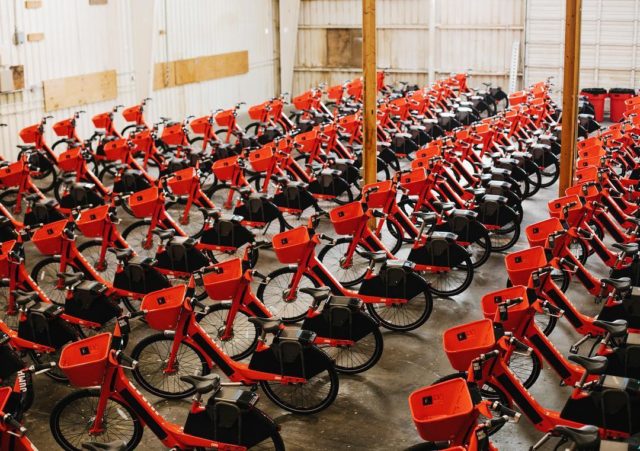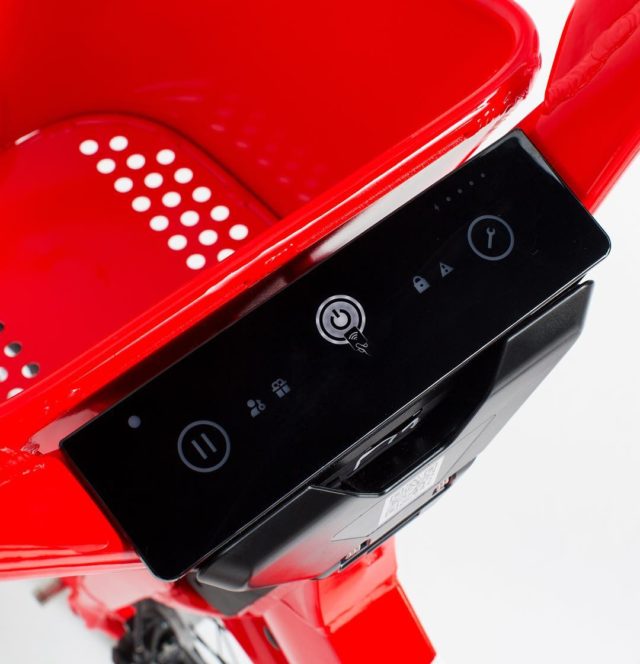Equity Program Scan Part 1: JUMP
by Farrah Daniel, Better Bike Share Partnership Writer
March 24, 2020
 Photo courtesy of JUMP
Photo courtesy of JUMP
Note: This series does not include a COVID-19 update.
Private companies have long invested significant amounts of stock in the shared micromobility landscape. While the coexistence of traditional and private companies has both ups and downs, is equity compromised by the goal to turn a profit?
In 2017, the Bureau of Transportation reported that households spent an average of $9,737 on transportation. Rural households, on the other hand, spent $10,293 compared to urban household’s $9,511.
The reality is millions of people can’t support these skyrocketing transportation costs. Creating accessible and equitable bike share programs means lower-income residents don’t have to pay a higher percentage of their income than financially stable people, and don’t have to jump through dozens of hoops to access this basic human right.
Portland State University’s Transportation Research and Education Center’s (TREC) 2019 research report compared equity-oriented programs across five bike share systems and measured program effectiveness on hiring practices, having electric bicycles, employee training, having an income-based discount, having an adaptive cycle program, and having a cash payment program.
Areas of improvement included marketing campaigns, transit integration, non-English offerings, and service area boundaries.
How might shared micromobilty companies meet some of these standards? In this series of four posts, we lay out the details of the equity-based programs offered by JUMP, Spin, Bird, Lime and Lyft.
Let’s start with JUMP.
Q&A With JUMP
 With JUMP’s redesigned front dashboard, riders can “pause” their rides or put the bike in repair mode when something is wrong. The dashboard was designed to be resilient and survive any number of weather conditions. Photo courtesy of JUMP.
With JUMP’s redesigned front dashboard, riders can “pause” their rides or put the bike in repair mode when something is wrong. The dashboard was designed to be resilient and survive any number of weather conditions. Photo courtesy of JUMP.
Originally founded as Social Bicycles in 2010, JUMP was acquired by Uber in 2018. It was the first dockless bike sharing system to launch in San Francisco and has since expanded to major cities like Atlanta, Los Angeles, Denver and more.
Colin K. Hughes, Head of Policy: Bikes and Scooters and Daniel Riff, Community Engagement, were willing to explain how JUMP prioritizes the implementation and sustainability of equitable solutions:
- How is JUMP currently prioritizing equity and access?
In addition to creating service areas that connect underserved communities to public transportation, JUMP is committed to building a service that is reliable, affordable, and accessible for people who are income-constrained, unbanked, or tech limited.
For example, in Sacramento, CA and Austin, TX, we found that half of residential JUMP bike rides begin or end in low-income residential areas. The data also showed that JUMP bikes have twice the pick-up/drop-off rate in low-income residential areas than that of medium and high-income areas.
BOOST Plan: Shown below.
Community Outreach: Our local teams promote the BOOST program at local events and through partnerships with local organizations. In San Francisco alone, we’ve hosted or participated in more than 300 community events and formed dozens of partnerships with local organizations.
Equitable Deployment: To ensure that our vehicles are equitably deployed on a day-to-day basis, our operations team members actively monitor vehicle concentration across neighborhoods in our fleet management software. This tool monitors the number of vehicles distributed across specified, predetermined areas.
In Washington DC, we’re providing a $3 incentive for all JUMP riders who end a trip at a parking corral in an Equity Emphasis Area (EEA). EEAs are defined as Census tracts with higher than average concentration of low-income, minority populations or both. JUMP unlocks connectivity to public transportation by connecting people from their trip origin/destination to a transit stop, often referred to as solving the first mile/last mile transportation gap.
In Sacramento, we recently partnered with the Regional Transit District to offer free light rail rides for anyone that used a JUMP bike to get to a light rail station. To expand the reach of existing transit options, we take a thoughtful approach to program design, which includes service area design and vehicle distribution. In Washington, D.C., many of the areas with the lowest transit frequency and limited access to docked bike share are experiencing JUMP activity. In fact, over a third of all JUMP rides begin or end in the areas that are lowest in terms of transit frequency.
Adaptive Vehicles: JUMP supports the development and implementation of long-term solutions that support point-to-point transportation for people with disabilities. In San Francisco, JUMP launched an adaptive vehicle pilot to serve people who may experience barriers to participate in our scooter and bike share programs. Throughout 2020, SF users can visit the Jump San Francisco website and reserve an adaptive scooter for up to 2 hours. We will use feedback from this pilot to inform future developments of our adaptive vehicles program.
Cash Payment: Cash payment is an option for JUMP bikes and scooters rentals through the Uber and JUMP app. Users without a smartphone can still ride with JUMP [with] Call to Unlock.
- How do you plan to improve or make your equity programs more available in 2020?
We’ll be engaging in direct discussions with current BOOST riders to understand how they think the program can be improved. We will also be speaking with eligible non-riders about how we could make the program more appealing to them — either through how we promote the program or the structure of the program itself. In addition to these conversations, we’ll be engaging our community partners to understand how well the program is set up for the populations they work with, and if there are things we can improve.
We will promote our BOOST program more actively through local events, community partnerships, and by working more closely with municipal agencies. We understand that the most effective way to increase participation in the program is to work with local partners who have established relationships in low-income communities, and we’re excited to work with them to increase equitable transportation access.
- How many people access your equity programs / what are the top markets?
Thousands of riders have enrolled in our BOOST program nationally, and BOOST riders complete about 5% of total trips in some markets.
- How does JUMP address diversity in the workplace?
Within JUMP, we believe that having diverse team members is critical for ensuring the best possible working environment and supports operational excellence that reflects all points of view. In all cities where JUMP operates, we have significant experience reaching out to community groups, partnering with diverse employment supplier partners (often Disadvantaged Business Enterprise/Women’s Business Enterprise), leveraging our diversity sourcing team, and publicizing our equal hiring policies.
The BOOST Plan
 Photo courtesy of JUMP
Photo courtesy of JUMP
One of JUMP’s equity efforts includes free helmet distribution in nine of the 18 cities the system operates in: Atlanta, Austin, Baltimore, Dallas, Miami, Nashville, New Orleans, Tampa, Washington D.C.
The BOOST bike share equity program is detailed below:
| Cities | Cost | Cash payment | Eligibility |
|---|---|---|---|
| Atlanta | $5/month for one 60 minute-trip — $0.07/minute for each additional minute | Yes |
|
| Austin | $5/month for one 60 minute-trip — $0.30/minute for each additional minute | No | Anyone 18+ currently enrolled in the Transit Empowerment Fund or Austin Energy CAP Discount. |
| Baltimore | $5/month for one 60 minute-trip— $0.07/minute for each additional minute | No |
|
| Chicago | $5/month for 30 min per day | Available via Uber Cash gift cards |
|
| Dallas | $5/month for one 60 minute-trip — $0.30/minute for each additional minute | No |
|
| Denver | $5/month for 60 minutes of daytime riding — $0.25 for each additional minute | No |
|
| Los Angeles |
|
No |
|
| New Orleans | $20 per year for 60 minutes of ride time per day | No | Louisiana Purchase (SNAP) or Medicaid |
| Providence | $5 for the first year, then $5/month for 60 minutes of ride time per day — $0.15 for each additional minute | Available via Uber Cash gift cards |
|
| Santa Cruz | $5/month for 60 minutes of ride time per day — $1.00 to unlock a bike after the initial 60 minutes, and $0.15 for each additional minute | No | PG&E Care program and CalFresh |
| San Diego | $5/month for 60 minutes of ride time per day — $0.07 for each additional minute | Available via Uber Cash gift cards |
|
| San Francsico |
|
No |
|
| Seattle | $5/month for one 60 minute-trip per day — $0.07/minute for each additional minute | Available via Uber Cash gift cards |
|
| Washington D.C. | $5/month for one 30 minute-trip per day — $0.25/minute for each additional minute | No |
|
Did we miss anything? Reach out on Facebook, Twitter and Instagram and let us know!
The next company we’ll be looking at is Lyft! Stay tuned for the upcoming post.
Don’t forget to check out the rest of the series:
- Equity Program Scan Part 2: Lyft
- Equity Program Scan Part 3: Lime
- Equity Program Part 4: Spin & Bird
The Better Bike Share Partnership is a JPB Foundation-funded collaboration between the City of Philadelphia, the Bicycle Coalition of Greater Philadelphia, the National Association of City Transportation Officials (NACTO) and the PeopleForBikes Foundation to build equitable and replicable bike share systems. Follow us on Facebook, Twitter and Instagram or sign up for our weekly newsletter. Story tip? Write farrah@peopleforbikes.org
